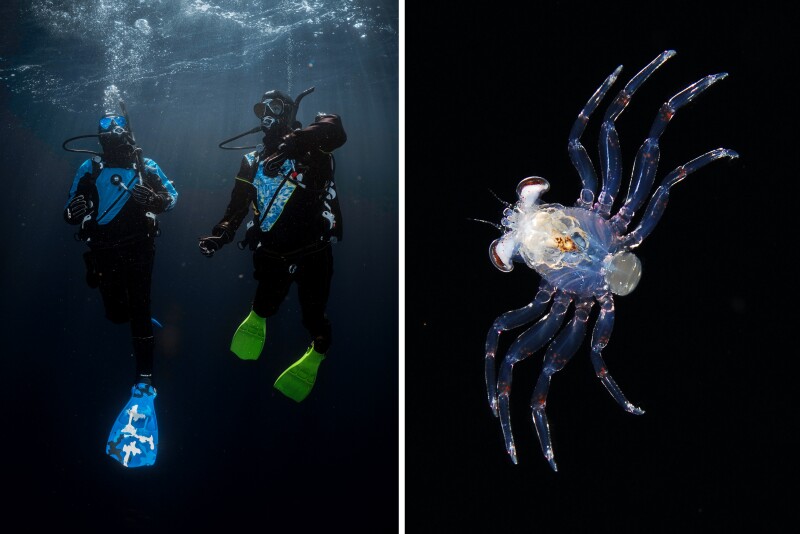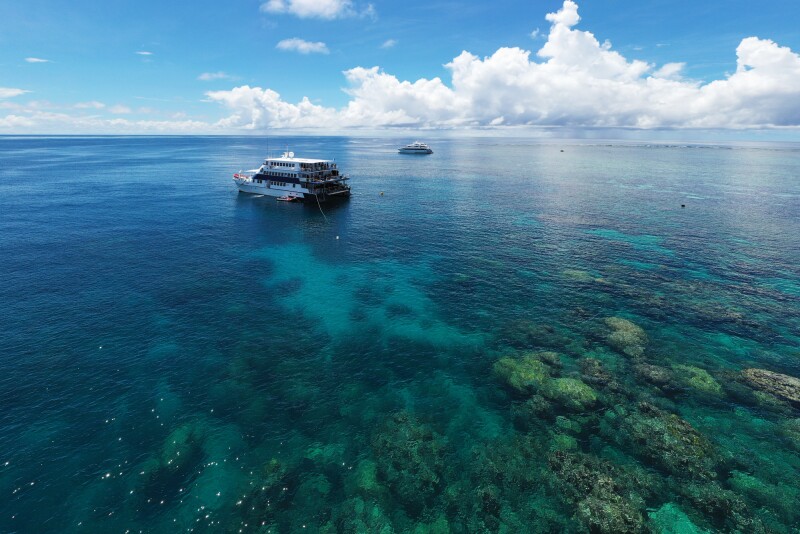It’s 7:30 p.m., the sun has been down for about an hour, and I’m getting ready to plunge into the inky black water of the Great Barrier Reef. Below me is a group of hungry whitetip reef sharks, hunting for snapper and baitfish, circling our boat. I step off the Spirit of Freedom, a 122-foot liveaboard home to 26 overnight guests, floating near the central ribbon reefs off the northeast coast of Australia. Moments later, I descend underwater, the dark waterline rising in front of my mask as I drop roughly 60 feet below the surface.
In the beam of my light, I can see flashes of sharks darting in all directions: a dorsal fin zipping below me or a curved, shimmering tail fin whipping in my periphery. The water is so rife with the ancient predators that our guide warned us not to hover our lights on sleeping fish, lest they become an easy meal for a shark. Keeping that in mind, I try not to shine it on my friends’ scuba diving fins or air hoses, either, in case the bits are mistaken for a tasty bite. I spend the next 45 minutes amid the melee.
When we resurface, my diving group bubbles with excitement while discussing the feeding frenzy below, laughing at our good fortune.
It may sound like it takes a certain rare kind of bravery, or perhaps stupidity, to scuba dive in pitch black water full of feeding sharks. Yet the appeal is calling to more—and even to newly certified—divers. “I’ve been in the dive industry for more than 30 years, and in that time, the number of people experiencing their first night dive has nearly tripled,” says Danny Dwyer, operating director for PADI Asia Pacific.
“From my experience, around 70 percent of people [on our trips] are excited to go night diving,” says my guide Melissa Alps, Dive Operations manager for Entrada Travel Group, which operates the Spirit of Freedom liveaboard. Another 20 percent or so are nervous or unsure, she says, while only about 10 percent of people sit it out.
Our dive site is called Challenger Bay, and while it’s calm during the day, it’s rife with activity at night, as each rung on the aquatic food chain tries to find a meal without becoming one themselves. Despite this, Alps says the fact that divers are forced to focus only on what they can see in their flashlight makes it feel very meditative and singularly focused. “You never know what will emerge from the darkness,” she says.
Why so many people are exploring the ocean at night

Millions of people are learning to dive, and scientists are learning more about marine life’s nocturnal habits.
Photo by PADI (L); Randy Wright (R)
Whether on the Great Barrier Reef, in southern California, or deep into the Red Sea, a whole new set of marine creatures is active at night, many that are almost impossible to find during the day. From glowing bobtail squid near Hawaiʻi to the nocturnal red “Spanish Dancer” nudibranchs (so named for their resemblance to spinning flamenco dancers) occasionally seen in Indonesia, the ocean hosts a different cast of characters at night. Even species that you may see during the day, such as seahorses, as well as invertebrates like crabs, mollusks, and lobsters, are more than 300 percent more active at night. During my night dive at Challenger Bay, I noticed a three-foot-long serpentine creature with a gaping maw that looked straight out of a sci-fi movie. Back on the boat, I flipped through a fish ID book only to learn it was a unique type of sea cucumber (which are mostly nocturnal), seen so infrequently that it had yet to receive an official scientific name.
With millions of scuba divers certified over the last 50 or 60 years—PADI alone has issued more than 30 million certifications—there’s a natural increase in more niche underwater options, including night diving. And it doesn’t hurt that our knowledge of the oceans and rate at which new marine species are recorded has grown exponentially in the past decade.
“Night dives are a very popular option in the advanced [PADI] course, which is the course most people take after their initial open water course,” says Dwyer. While those interested can take optional night dive speciality courses, no additional certification is needed, allowing even newly certified open water divers to jump in after dark.
The best places to go night diving

The Great Barrier Reef in Australia is one diving option, but there are several other night diving opportunities in Hawai‘i, the Maldives, the Caribbean, and elsewhere.
Courtesy of Divers Den Cairns
Night dives vary almost as much as daytime ones, with most daytime sites available after dark, too. Alps says choosing a liveaboard is often the most comfortable option, allowing divers to “step straight out of the water into a warm shower, enjoy a hot drink, and discuss the marine life you just saw,” rather than taking a long boat ride back to a land-based resort. But there are several other appealing options as well.
On Hawaii’s Big Island, divers can book specialty manta feeding night dives. “That was sort of the exclusive activity for a handful of people that knew about it,” says Eric Albinsson, who oversees Instructor Development for PADI in the Americas. During the dives, lights on the bottom of the boats attract plankton, which in turn attract giant mantas; divers get to see them from just feet away floating in and out of the darkness. Also available on the Big Island are blackwater dives, in which divers are tethered 50 feet below the surface in open ocean, holding a dive light and waiting to see what creatures come by.
Fluorescence Night Dives, also called “Fluo dives,” are becoming more and more popular. While some marine creatures produce their own light via bioluminescence, others can be illuminated by a blue light divers hold on fluo dives. Biofluorescent marine creatures can absorb that blue light but reflect back the green, orange, and red wavelengths (filtered through the diver’s yellow-tinted mask), giving the creatures an otherworldly glow. At least 180 types of fish display this behavior, including common fish like blennies. Versions of this are increasingly available in dive hubs around the world, usually in areas with reefs close to shore, like the Maldives, French Polynesia, St. Maarten, and Bonaire.
Muck diving is the term for diving in areas with sandy, silty bottoms, in order to look for tiny creatures that hide in the ocean floor. Many of these creatures are more active, and thus easier to find, at night. “It’s not just different creatures,” says Albinsson, “but different behavior.” Dive shops in areas known for muck diving, like Anilao in the Philippines or Indonesia’s Lembeh Strait, usually offer night diving.
For shark and pelagic action, Challenger Bay on the Great Barrier Reef is unbeatable. Alps says she’s never seen fewer than 5 sharks on a night dive there, though I must have seen at least 25 on our visit. Its distance off the mainland makes it best accessed via Cairns-based liveaboard dive boats, and Dwyer advises diving it first during the day. He notes, “Most divers are surprised by how different a familiar dive site looks at night.”











